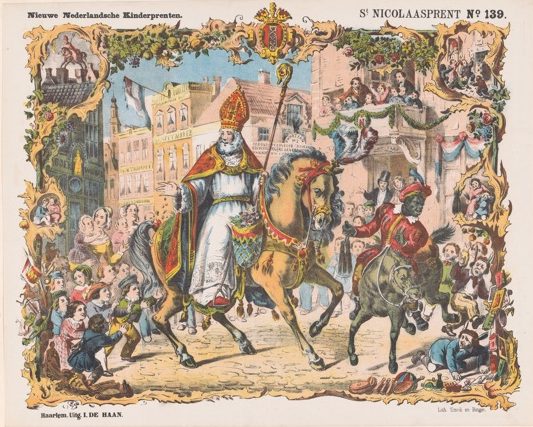Design & Activism Issue 5 2021
Will Zwarte Piet Ever Be Kicked Out?
Catherine Powell

Fig 1. Logo. Zwarte Piet is Racisme, 2011.
In the Netherlands, young children look forward to the arrival (by boat) of Sinterklaas—a character who shares origins with Santa Claus and marks the celebration of the feast of Saint Nicholas usually held on the evening of December 5. Sinterklaas distributes presents and candy to Dutch children, aided by Zwarte Piet (Black Pete). Zwarte Piet is easy to recognize: black curly wig, bright red lips, large gold earrings, colorful costume, and a face painted black.1
For several years, a debate has raged: is Zwarte Piet a racist colonial hangover or a harmless tradition?2 (Fig. 1) In 2014, a Dutch activist group formed called “Kick Out Zwarte Piet” (KOZP), and in 2015, the United Nations took a stand when it condemned racist depictions of Zwarte Piet and urged the Dutch government to act to facilitate dialogue and combat racism. Nevertheless, with each passing year the debate has grown more volatile, leading at times to physical confrontation between anti- and pro-Zwarte Piet groups.

Fig. 2 Emrik en Binger, Intocht van St. Nicolaas (Haarlem: Edition I. de Haan, 1870). Rijksmuseum.
The visual culture associated with Zwarte Piet arcs back to children’s books of the 1850s. A 2014 exhibition entitled “The birth of Zwarte Piet,” at the Rijksmuseum, traced the evolution of the imagery throughout the nineteenth and early twentieth centuries. As can be seen from a color lithograph of 1870 (Fig. 2), no positive associations can be made to it. Indeed, researchers at the University of Groningen found that the appearance of Zwarte Piet barely changed between 1850 and 2013, as is clearly shown by a book cover from 2007 (Fig. 3).3
Then came the killings in the US in 2020 of George Floyd and Breonna Taylor. Black Lives Matter demonstrations sprung up around the world. Dutch Premier Mark Rutte (an earlier supporter of the Zwarte Piet tradition) announced that having met many people “with a dark skin color who said they felt incredibly discriminated against because Zwarte Piet was black,” he has recognized “That’s the last thing you want at a Sinterklaas party.”4 Zwarte Piet is now banned on social media and, as of 2019, from participating in Amsterdam’s Sinterklaas.5

Fig. 3 Vivian den Hollander and Natascha Stenvert (illust.), Vandaag ben ik…Zwarte Piet! (Houten: Van Holkema & Warendorf, 2007).
Things, however, do appear to be changing, lurching forward thanks to BLM movements and protests. For example, in November 2020, public librarians in the Netherlands announced that they were destroying children’s books depicting Zwarte Piet in the traditional idiom. Unfortunately, not everyone has been equally inspired. In that same month, in Maastricht, the riot police had to intervene to quell escalating tension between anti-Zwarte Piet protesters and counter-protestors. For myself, currently living in South Holland and walking into a local national department store in Leiden on the morning of December 5, 2020, I was dismayed to be greeted by two cheerful young women standing in for Zwarte Piet, their faces painted black. Will Zwarte Piet ever be kicked out?
has her MA in History of Design and Curatorial Studies from Parsons School of Design. During her time in the program she was Editor-in-Chief of Issue 2 of Objective. She is currently a PhD candidate for Art History at the University of Texas at Austin and is a Kress Institutional Fellow at Leiden University Centre for the Arts in Society (LUCAS).
Notes
- I refrain from using the expression “blackface,” which has a deep American cultural significance and roots that differ from those of Dutch colonialism and racism.
- The organization EenVandaag has surveyed an opinion panel consisting of 29,000 individuals every year between 2013 and 2020. It has found that support for Zwarte Piet has decreased almost consistently over the survey period, from 89% to 55%.
- C. Vermuyen, and N. Schuiling, De representatie van Zwarte Piet in kinderboeken (1850–2013) (Groningen: Science Shop, University of Groningen, 2019).
- “Rutte: ik ben anders gaan denken over Zwarte Piet,” NOS Nieuws, June 5, 2020.
- There was no Sinterlcass parade in 2020 due to COVID-19.
